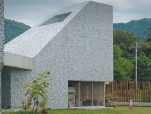The Architecture of Happiness

In the recent past Colombia had an unenviable fame of criminal and extremely dangerous place with prevailing number of poor inhabitants, but today things have changed a lot and last but not least thanks to architecture. Architects did a tremendous amount of research devoted to the cities and towns of their country to show it to the government in order to persuade them to consider the proposed development for its subsequent use. Since then architecture of Colombia has become a tool and a symbol of social policy changes and it even turned out later that thanks to it a beneficial effect on other South American countries was caused, where the authorities have also begun to work closely with architects, to consult with them on not only architectural topics, but also on questions of strategic cities development.
It all started with only few public buildings, one of which was a kindergarten Timayui project designed by studio Giancarlo Mazzanti. How such a small and seemingly insignificant building could radically improve economic reality of the place, raise people’s sense of pride and respect, change society and make it develop along with the new project?
Let’s start with the fact that behind the Timayui kindergarten architectural concept there is a pedagogical model system of Reggio Emilia, named after the Italian city where it was first developed and implemented by pre-school teacher, psychologist and philosopher Loris Malaguzzi. This system was also emerging in the particular post-war period in the country and a common idea of people at that time was to raise a new generation who would feel themselves free, would not afraid to think by themselves, to explore and to create.
Malaguzzi noticed that “Child has three teachers: adult, another kid and space by which the child is surrounded” and he was considering environment, architecture of kindergarten – an issue of main importance, in fact, the “third teacher”. Because of this, as the very first school, built in the system of Reggio Emilia, as well as those built later or even today always have very special and particular design solutions.
Full content of this issue you can read here
The full version of the article can be read in our printed issue, also you can subscribe to the web-version of the magazine
 Text: Elizaveta Klepanova
Text: Elizaveta Klepanova
Illustrative Materials Provided by Giancarlo Mazzanti


